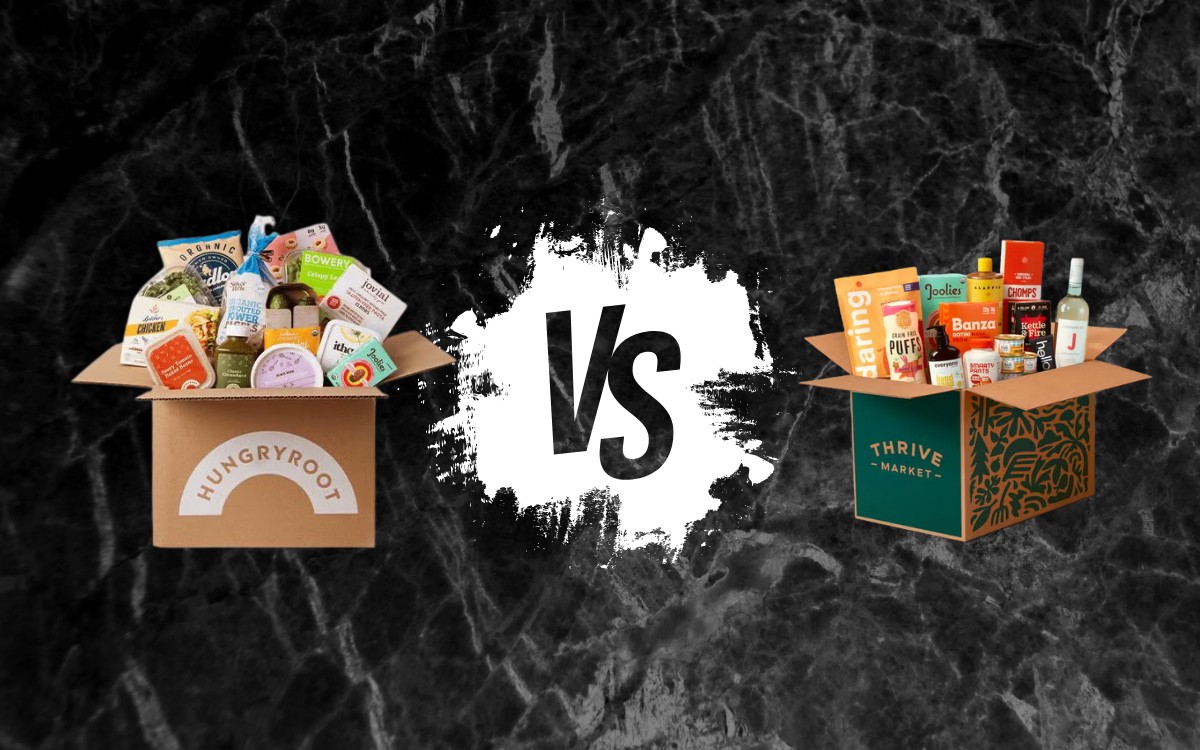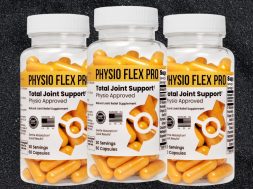
Finding food that fits real life is harder than it should be. As someone who trains hard, works, and raises two young kids, I’m constantly walking the line between eating for performance and staying sane during the week.
Meal prep can only take you so far when your day starts before sunrise and ends after bedtime. That’s where services like Hungryroot and Thrive Market promise to help, each taking a different shot at simplifying how we shop, eat, and stay fueled.
Over the past month, I tested both services for two full weeks each. Hungryroot gave me quick, personalized meal kits designed to get dinner on the table in under 20 minutes, while Thrive Market acted more like an online health-focused grocery store.
My goal wasn’t to see which one was fancier or trendier. I wanted to know which service actually supports a high-protein, performance-oriented lifestyle while still working for normal people who just want healthy, practical food that fits a busy life.
Quick Verdict
After testing both for a full month, the difference is clear. Hungryroot makes eating healthy almost effortless, with quick, tasty meals that fit busy schedules, but the portions and price won’t fully satisfy anyone training hard without extra add-ons.
Thrive Market offers more control and better long-term value, letting you stock up on quality ingredients and cook real, high-protein meals your way, but it takes more time.
If you want pure convenience, Hungryroot wins. If you want flexibility and consistency, Thrive Market is the smarter pick.
But for serious athletes who need performance-level nutrition with zero prep, Trifecta Nutrition remains the only option that truly delivers. Its meals arrive fully prepared, macro-balanced, and designed to fuel recovery without any compromise on quality or flavor.
| Feature | Winner |
|---|---|
| Customization | Thrive Market |
| Meal Kits and Variety | Hungryroot |
| Taste and Quality | Draw |
| Packaging | Thrive Market |
| User Reviews | Draw |
| Cancelation Process | Draw |
| Price | Thrive Market |
Winner
Based on my experience with each meal delivery service, neither Hungryroot nor Thrive Market hold a light to Trifecta Nutrition.
Trifecta caters to any allergies or dietary preferences and has a Performance Line with meals that don’t skimp on protein or calories.
They are high protein, moderate carb, and lower in fat making them perfect for muscle building, fat loss, or sports performance related goals. Use code “liftbig40” for 40% OFF.
What Is Thrive Market?
Thrive Market isn’t a meal kit; it’s a members-only online grocery store focused on clean, organic, and sustainable products. You pay either $59.95 per year or $12 per month for membership, which gives you access to discounted pricing on thousands of foods, snacks, frozen meals, and household goods. Free shipping kicks in at $49 for pantry items and $120 for frozen goods.
You can shop by diet, including popular choices like high-protein, keto, gluten-free, paleo, vegan, or simply browse by category.
The platform gives you full control: meats, frozen seafood, nut butters, sauces, protein snacks, even supplements. It’s like a Whole Foods meets Costco hybrid, built for online convenience.
For me, after using it for two weeks of testing, the shopping felt truly streamlined.
I could set up recurring staples like grass-fed ground beef, wild-caught salmon, Greek yogurt, rice, and kids’ snacks, and they arrived neatly packed, frozen items rock solid, pantry goods intact. I liked that I wasn’t tied to a menu. It worked like a supply chain for my own kitchen.
Of course, that’s also the catch. Thrive Market saves you time grocery shopping, but you’re still cooking. There are no recipe cards or pre-portioned ingredients waiting in the box. It’s built for people who already have a basic meal structure or who enjoy prepping food themselves.
For athletes or active people who follow a consistent diet, Thrive Market fits naturally. For those who want variety, recipes, or zero prep, it may feel more like homework.
Pros
- Huge selection of healthy, organic, and high-protein groceries.
- Competitive prices that offset the membership fee with regular use.
- Strong sustainability focus and recyclable shipping materials.
- Excellent for stocking up on pantry staples and meal prep basics.
- Flexible ordering with no recurring shipments or preset menus.
Cons
- Requires cooking and meal planning, and no ready-to-eat options.
- Fresh produce selection is limited compared to physical stores.
- Free shipping only applies above certain order minimums.
- Occasional shipping delays or out-of-stock items reported.
- Membership cost only makes sense if you order consistently.
What Is Hungryroot?
Hungryroot is a hybrid between a grocery delivery service and a meal kit. When you sign up, you take a detailed quiz about your dietary preferences, goals, allergies, and how many meals you want to prepare each week.
From there, Hungryroot automatically builds your box with groceries and simple recipe combinations. Think fresh vegetables, cooked proteins, sauces, grains, and snacks, all designed to work together across different dishes. You can follow the suggested recipes or freestyle.
What makes Hungryroot unique is how personal it feels. After two weeks of testing it, I found it adapts almost instantly. When I rated certain meals higher, the next week’s recommendations leaned heavier on those kinds of flavors and protein profiles.
The average meal took 10 to 15 minutes to make, and all the ingredients were clean, minimally processed, and fresh. It felt closer to assembling than cooking, which was perfect on nights when I came home late from the gym or when the kids needed to eat fast.
Still, Hungryroot isn’t cheap. Prices range from $9.69 to $11.39 per serving, and an average week’s box costs between $100 and $155, depending on your selections.
That’s more than grocery shopping but less than takeout, though the smaller portions mean serious eaters might need to add extra sides or protein to feel satisfied.
In short, Hungryroot simplifies your life by planning and partially prepping for you, and its main advantage is convenience. You can read my Hungryroot review for my experience.
Pros
- Extremely convenient; meals take 10–20 minutes to prepare.
- Personalized weekly boxes tailored to diet and goals.
- Fresh, minimally processed ingredients with good flavor balance.
- Easy to modify orders, swap items, or add snacks.
- Ideal for busy people who still want to cook at home.
Cons
- Smaller portions that may not meet higher protein or calorie needs.
- More expensive per serving than standard grocery shopping.
- Limited meal complexity; recipes can feel repetitive over time.
- Relies heavily on plastic packaging despite recyclable options.
Thrive vs Hungryroot: Main Differences
Customization
Hungryroot personalizes everything from the start. The quiz tailors meals based on your diet — high protein, vegan, gluten-free, low carb, etc.
I selected “high-protein omnivore” and got options like grilled chicken grain bowls, teriyaki beef stir-fry, and roasted veggie tacos. Each week, I could swap ingredients, add snacks, or increase serving sizes. It’s intuitive, and I liked not having to think about what to cook next.
Thrive Market, on the other hand, gives you full control without structure. You build your box like a grocery run, nothing is pre-chosen.
It’s not personalized in the same way, but the filtering tools make it easy to find exactly what fits your macros or diet. You can tag searches like “high protein,” “organic,” or “low carb,” and fill your cart accordingly.
Hungryroot wins for guided customization and convenience. Thrive wins for total flexibility.
Meal Variety, Kits, and Recipes
Hungryroot’s recipe rotation kept things fresh. Across two weeks, I tried 10 different dishes, from shrimp tacos to chicken pesto pasta to a beef and black bean bowl.
The prep time rarely exceeded 15 minutes. Each recipe used real groceries, so I could repurpose leftover ingredients later. That flexibility is underrated.
The meals weren’t gourmet, but they were consistently tasty and balanced. The seasoning blends worked, and I didn’t have to chase down ingredients. It was plug-and-play cooking that still felt like real food.
Thrive Market isn’t a recipe service, so variety depends entirely on you. I used it to stock proteins and staples, then cooked meals I already knew how to make, such as salmon with quinoa, beef stir-fry, omelets, and wraps.
If you like experimenting, Thrive offers endless potential, but you’re on your own for meal ideas.
For busy men who need dinner ready fast, Hungryroot’s pre-designed recipes are a big advantage. For people who enjoy cooking or meal prep Sundays, Thrive offers more creative range.
Taste and Quality
Hungryroot impressed me more than I expected. The ingredients arrived fresh, nothing wilted or soggy, and the proteins were well-trimmed and pre-cooked but not rubbery.
The sauces were flavorful without tasting artificial or loaded with sugar. My favorite was the spicy chicken stir-fry, which had a clean, mildly tangy flavor and crisp vegetables.
That said, I had to double the protein portions in most meals to meet my training needs. Hungryroot’s default servings hit around 30 to 35 grams of protein per meal. I usually aim for 45 to 60, so I’d throw in an extra chicken breast or scoop of rice to round things out.
Thrive Market’s quality varies by brand, but overall it’s high. Their private-label meats and frozen seafood are clean, well-packaged, and come from trusted sources.
The produce selection is limited compared to local stores, but the pantry items like olive oil, nut butters, seasonings, and protein snacks are excellent. I noticed everything was packaged securely, and the frozen box arrived packed in dry ice.
Taste-wise, Thrive is what you make it. The quality ingredients are there, but the end result depends on your cooking. Hungryroot delivers consistent results because it does the flavor matching for you.
Packaging
Both services handle packaging well, but Thrive Market is more sustainability-oriented. Their boxes are recyclable, insulated liners are compostable, and frozen shipments use dry ice that evaporates cleanly.
Hungryroot’s packaging felt more like a traditional meal kit: individual bags and containers, labeled by recipe or item. Most of it was recyclable, though the plastic count was higher. Everything arrived cold and well-organized, but the environmental impact is heavier.
For efficiency and eco-friendliness, Thrive has a slight edge. For convenience and clarity, Hungryroot wins.
Price
| Service | Payment Model | Typical Cost | Notes |
| Hungryroot | Per-serving inside weekly plan | $9.69–$11.39 per serving (avg. $100–$155 per week) | Free shipping for orders over $70; smaller boxes add $6.99 shipping |
| Thrive Market | Annual or monthly membership | $59.95/year or $12/month | Free shipping over $49 (pantry) or $120 (frozen); groceries priced individually |
Hungryroot is essentially a meal kit subscription — convenient, consistent, but expensive per calorie for active men. Thrive Market shifts the cost model to your habits. If you order once a week or bulk-buy staples, the membership quickly pays off.
During my test, I spent around $115 per week with Hungryroot and $95 per week with Thrive, not counting the one-time membership fee. The difference wasn’t massive, but Thrive’s portions and protein totals were higher because I bought raw ingredients in bulk.
Cancellation Process
Hungryroot makes cancellation easy, as long as you do it on time. You can pause or cancel directly through your account dashboard, but you must act before the weekly cutoff. If you miss it, the next box still ships and charges.
Thrive Market lets you cancel anytime. You can go through chat or their online portal. If you cancel within 30 days of signing up, you can request a full refund.
After that, your membership remains active until the end of the billing period. I found customer service responsive and quick to process requests.
Both are straightforward, but Thrive gives you more flexibility with no recurring shipment pressure.
User Reviews
Hungryroot’s average rating across platforms like Trustpilot hovers around 4.3 out of 5 stars. Most users love the variety and speed, while common complaints revolve around portion size, cost, and the occasional shipping error. That matches my experience — great food, small portions, not ideal for big appetites.
Thrive Market earns similar praise but for different reasons. Customers appreciate the prices, sustainability, and clean product selection.
Criticisms mostly involve delayed shipments or occasional damaged packaging. I didn’t experience any issues during my two weeks as both boxes arrived fast and cold.
My Experience with Thrive and Hungryroot
Two Weeks with Hungryroot
Week one felt like a relief. Meals took under 20 minutes, and I barely touched a cutting board. On training nights, I could have dinner ready before my kids finished their showers.
The chicken stir-fry, beef and black bean bowl, and turkey pesto pasta all tasted good, and honestly better than expected for something this quick.
I did notice the smaller portions right away. For me, one serving looked more like a light meal. I ended up adding cooked rice or a protein shake alongside dinner. My average dinner hit around 550 to 600 calories with those additions.
What Hungryroot nailed was time savings and convenience. It turned meal prep into assembly and cleanup was minimal. Every ingredient was labeled clearly, and the online dashboard made swapping meals easy.
By week two, I got into a rhythm. I started customizing more aggressively by replacing plant-based items with extra meats, adding snacks like almond butter packets and granola. The second box arrived fresher, with fewer packaging issues. It was a smooth process start to finish.
Two Weeks with Thrive Market
Switching to Thrive felt like taking back control. I built my own weekly menu using their filters for high-protein and organic items.
I ordered frozen wild-caught salmon, grass-fed ground beef, chicken breasts, quinoa, oats, Greek yogurt, and some healthy snacks for the kids. The frozen box came in perfect condition with dry ice still intact 24 hours later.
I meal-prepped Sunday for the week ahead. Having those staples ready gave me more freedom. I could mix and match — beef tacos one night, salmon rice bowls another, chicken wraps for lunch. I felt more satisfied because I was eating full athlete-sized portions again.
What I liked most was consistency. The quality didn’t fluctuate, and the cost felt predictable. With Hungryroot, prices varied weekly depending on what was in the plan. Thrive let me track exactly what I spent.
The trade-off, of course, was time. I cooked everything myself. Prep took about an hour on Sunday and another 15–20 minutes each night to finish meals. Not terrible, but noticeably more than the near-instant dinners Hungryroot gave me.
If I were in a training camp or chasing a specific body composition goal, Thrive would be my foundation. If I were buried in deadlines and wanted to survive the week with decent food, Hungryroot would be the move.
Should You Pick Thrive or Hungryroot?
Choose Hungryroot if your life is packed, your evenings are short, and you want fresh, balanced meals that don’t require planning. It’s ideal for busy professionals, parents, or anyone who hates grocery shopping. It’s less ideal if you eat like an athlete, and the portions and price will catch up to you fast.
Choose Thrive Market if you like control, care about ingredient quality, and don’t mind cooking. It’s perfect for people who meal prep, train seriously, or follow a structured eating plan. The membership pays off if you order regularly, especially for high-protein staples and pantry items.
But if your priority is performance-focused nutrition with zero prep, neither option beats Trifecta Nutrition. Trifecta delivers fully prepared, high-protein meals tailored to athletes.
They’re portion-controlled, organic, and macro-balanced right out of the box. During my testing, Trifecta’s meals consistently hit the 40–50-gram protein mark and required no cooking at all.
For busy men who train hard and need dependable fuel, Trifecta eliminates the trade-off between convenience and performance. Hungryroot and Thrive both make life easier, but Trifecta keeps you locked in on nutrition without losing time or energy.
Trifecta
Trifecta Nutrition
A clean, high protein meal delivery service that doesn’t skimp on quality or portions. Use code “liftbig40” for 40% OFF.











